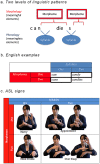Amodal aspects of linguistic design
- PMID: 23573272
- PMCID: PMC3616023
- DOI: 10.1371/journal.pone.0060617
Amodal aspects of linguistic design
Erratum in
- PLoS One. 2013;8(4). doi:10.1371/annotation/935f97a6-67f9-4331-a998-f94a62826194
Abstract
All spoken languages encode syllables and constrain their internal structure. But whether these restrictions concern the design of the language system, broadly, or speech, specifically, remains unknown. To address this question, here, we gauge the structure of signed syllables in American Sign Language (ASL). Like spoken languages, signed syllables must exhibit a single sonority/energy peak (i.e., movement). Four experiments examine whether this restriction is enforced by signers and nonsigners. We first show that Deaf ASL signers selectively apply sonority restrictions to syllables (but not morphemes) in novel ASL signs. We next examine whether this principle might further shape the representation of signed syllables by nonsigners. Absent any experience with ASL, nonsigners used movement to define syllable-like units. Moreover, the restriction on syllable structure constrained the capacity of nonsigners to learn from experience. Given brief practice that implicitly paired syllables with sonority peaks (i.e., movement)--a natural phonological constraint attested in every human language--nonsigners rapidly learned to selectively rely on movement to define syllables and they also learned to partly ignore it in the identification of morpheme-like units. Remarkably, nonsigners failed to learn an unnatural rule that defines syllables by handshape, suggesting they were unable to ignore movement in identifying syllables. These findings indicate that signed and spoken syllables are subject to a shared phonological restriction that constrains phonological learning in a new modality. These conclusions suggest the design of the phonological system is partly amodal.
Conflict of interest statement
Figures






Similar articles
-
The role of syllables in sign language production.Front Psychol. 2014 Nov 13;5:1254. doi: 10.3389/fpsyg.2014.01254. eCollection 2014. Front Psychol. 2014. PMID: 25431562 Free PMC article.
-
Comparing action gestures and classifier verbs of motion: evidence from Australian Sign Language, Taiwan Sign Language, and nonsigners' gestures without speech.J Deaf Stud Deaf Educ. 2005 Summer;10(3):272-90. doi: 10.1093/deafed/eni029. Epub 2005 Apr 27. J Deaf Stud Deaf Educ. 2005. PMID: 15858072
-
ANCHORING is amodal: Evidence from a signed language.Cognition. 2018 Nov;180:279-283. doi: 10.1016/j.cognition.2018.07.016. Epub 2018 Aug 10. Cognition. 2018. PMID: 30103208
-
Visual and linguistic components of short-term memory: Generalized Neural Model (GNM) for spoken and sign languages.Cortex. 2019 Mar;112:69-79. doi: 10.1016/j.cortex.2018.05.020. Epub 2018 Jun 7. Cortex. 2019. PMID: 30001920 Review.
-
Syllable as a unit of information transfer in linguistic communication: The entropy syllable parsing model.Wiley Interdiscip Rev Cogn Sci. 2020 Jan;11(1):e1518. doi: 10.1002/wcs.1518. Epub 2019 Sep 10. Wiley Interdiscip Rev Cogn Sci. 2020. PMID: 31505710 Review.
Cited by
-
Commentary: "An Evaluation of Universal Grammar and the Phonological Mind"-UG Is Still a Viable Hypothesis.Front Psychol. 2016 Jul 14;7:1029. doi: 10.3389/fpsyg.2016.01029. eCollection 2016. Front Psychol. 2016. PMID: 27471480 Free PMC article. Review.
-
Gesture, sign, and language: The coming of age of sign language and gesture studies.Behav Brain Sci. 2017 Jan;40:e46. doi: 10.1017/S0140525X15001247. Epub 2015 Oct 5. Behav Brain Sci. 2017. PMID: 26434499 Free PMC article. Review.
-
Lexical access in sign language: a computational model.Front Psychol. 2014 May 15;5:428. doi: 10.3389/fpsyg.2014.00428. eCollection 2014. Front Psychol. 2014. PMID: 24860539 Free PMC article.
-
Turn-timing in signed conversations: coordinating stroke-to-stroke turn boundaries.Front Psychol. 2015 Mar 24;6:268. doi: 10.3389/fpsyg.2015.00268. eCollection 2015. Front Psychol. 2015. PMID: 25852593 Free PMC article.
-
Phonological reduplication in sign language: Rules rule.Front Psychol. 2014 Jun 10;5:560. doi: 10.3389/fpsyg.2014.00560. eCollection 2014. Front Psychol. 2014. PMID: 24959158 Free PMC article.
References
-
- Hockett CF (1960) The origin of speech. Sci Am 203: 89–96. - PubMed
-
- Prince A, Smolensky P (2004) Optimality theory: Constraint interaction in generative grammar. (Originally published as a technical report in 1993.) Malden,MA : Blackwell Pub.
-
- McCarthy JJ, Prince A (1998) Prosodic morphology. In: Spencer A, Zeicky AM, editors. Handbook of Morphology.Oxford: Basil Blackwell. pp. 283–305.
-
- Fitch WT, Hauser MD, Chomsky N (2005) The evolution of the language faculty: clarifications and implications. Cognition 97: : 179–210; discussion 211-125. - PubMed
-
- MacNeilage PF (2008) The origin of speech. New York:Oxford University Press .xi, 389 p.
Publication types
MeSH terms
Grants and funding
LinkOut - more resources
Full Text Sources
Other Literature Sources

